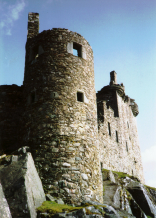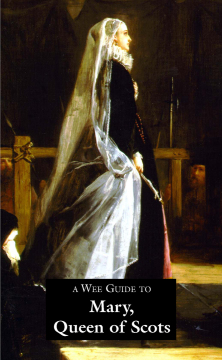Mary Queen of Scots: Stewart Scotland
Mary, Queen of Scots was executed at Fotheringhay Castle, in England, in 1587. Some have seen her as a martyr, others as a failure. She inherited the Scottish crown
when she was only six days old, during a period of strife in Scotland, and indeed the rest of Europe. She then spent 13 years in France from the age of five, and later 19 years in captivity in
England. During these years Mary spent a mere seven years in Scotland, when she ruled the country in her own right. Whatever opinion is about Mary’s personal rule, she faced many unique problems
during her reign, not the least being the religious changes which occurred during the Reformation. She has often been compared unfavourably to other Stewart monarchs – perhaps because they were male
– and yet neither her father nor grandfather might be seen as having been any more successful.
In 1542, the year of Mary’s birth, James V – her father – followed his more popular father’s example by commanding a Scottish army to yet another major defeat by the
English. The battle at Solway Moss may not have resulted in such a huge loss of life as Flodden, but the consequences of the battle were just as serious for the kingdom and the Scots.
Because of a mutual defence agreement made with France, James IV had led his army of men, drawn from throughout his kingdom, highland and lowland, to battle at Flodden in 1513
against the old enemy England. Both Louis XII of France and James were aware that Henry VIII of England might plan to invade either, or both, their kingdoms. Henry VIII’s invasion of France led to
James’s invasion of Northumberland, while Henry was occupied in France.
But Henry had left contingency plans anticipating this
possibility, and had left the Earl of Surrey with the power to assemble an army if required. Surrey was able to call up 26 000 men, as against James’s 35 000, and challenged the Scots to battle
on 9 September 1513. The odds may have been with James theoretically, but the tactical superiority of the English, and the use of short bills (a short spear-like weapon which could be used either to
stab like a spear or slash like an axe) which proved more effective than the Scottish pikes (fifteen-foot long spears which required skill and training to use effectively, neither of which the Scots
had), contributed to a heavy loss of life. There may have been as many as 9 000 Scots slain, and 4 000 English, but most seriously for the Scots was the loss of their
popular king, and many of his most senior nobles and advisors.
When James V succeeded to the throne at the tender age of 17 months Scotland again had a minor as a monarch and government by regency. The rivalries between some of the oldest
families in Scotland did little to restore peace to a country which had suffered the loss of so many men. The mutual defence alliance continued with France, and therefore relations with England
remained distinctly distant, despite the fact that the Queen Mother was Margaret Tudor, Henry VIII’s sister.
James V was very much the opposite of his father. James IV had been an energetic and popular king. He was intelligent, tall and athletic, spoke several languages including Gaelic,
and was a true renaissance king interested in music, art, architecture and science. He remodelled the royal palaces of Linlithgow, Falkland and Holyrood Palace, Edinburgh; attempted to establish a Scottish navy by building the
Great Michael and founded a new university at Aberdeen. He also ratified the establishment of an Incorporation of Surgeons in Edinburgh in 1506 as a result of his interest in science and
medicine. His son had few of these accomplishments apart from continuing the Stewart males’ success with women, producing several illegitimate children.
In 1528 when James V was 16 years old, he took over ruling the kingdom in his own right, and attempted to crush the Douglases who had imprisoned him during his minority. He also
attempted to restore law and order in outlying areas of the country, particularly the borders, highlands and islands.
Unfortunately although his heavy-handedness may have restored a form of order it did little to inspire loyalty and confidence in the king. Having alienated the Douglases, he then went on to alienate the Armstrongs in the borders and the MacDonalds in the highlands. The removal from power of these major families led to others becoming equally dominant, and in later years they would not come to James’s support when he was at war with England.
James also abused his monarch’s right of appointments to the major church benefices by granting five of his illegitimate sons rich positions. By placing
them in positions of authority in the church, he ensured that the church supported royal authority and was a major source of income for the crown.
During James’s reign international events affected Scotland’s domestic situation as much as her relations with other countries. One of the major European developments, which was to
influence Scotland over the next generation, was the start of the religious Reformation in Europe. Also important were the relations, cordial or otherwise, between the major powers of England,
France, Spain and the Holy Roman Empire in which Scotland had its part to play.
Royal marriages were always important and often did not involve love or even attraction. Dynastic associations and allegiances between countries were at the forefront of most
marriage negotiations. James’s choice of bride was of international importance despite the fact that Scotland was not as powerful as France or England. Neither France nor England wished James to
marry a Spanish bride, but a French bride was also an unacceptable choice to the English.
The nominal peace which had been established between England and Scotland continued, but there were repeated minor skirmishes involving the two countries. By 1533 France would not
support Scotland against England as relations were relatively friendly between the two. Henry VIII, because of his religious stance, was isolated from the rest of Europe and looked to his northern
relative to support him, but as James had burnt Protestant heretics in the 1530s, he had no intention of breaking with Rome, and the rest of Europe, on Henry’s behalf.
By 1536 James had made clear his intention of marrying a French bride and a marriage to Princess Madeleine of France was arranged. She died less than six months after their wedding
at Stirling Castle, but James found another suitable bride in Mary of Guise, and
thus managed to acquire two large French dowries in the process. This bound Scotland and France even more tightly. Charles V, the Holy Roman Emperor, and François I of France signed treaties in 1537
and 1538, supporting the actions of the Pope against Henry, but this allegiance of old rivals did not last and by 1541 both independently asked Henry for his support against the other.
In Scotland, James’s avarice and his heavy-handed government contributed to a dwindling loyalty amongst his subjects, and to some extent the growth of a pro-English party among
some Scots, which was to have serious consequences.
The final crisis of 1542 was the culmination of personal loss, domestic mismanagement and international events. In the spring of 1541 the two young sons of James and Mary of Guise
both died, a loss of the security of succession so vital to reigning monarchs. The following year Henry, who still hoped to persuade his nephew to join with him, asked him to a meeting at York. James
agreed to attend but his privy council were against the proposal, both out of fear for James’s life and because the Scottish clergy were against Henry’s religious policy and did not want James to
follow his example.
Henry VIII, in retaliation for the non-appearance of James, organized his forces for an invasion of Scotland. Sir Robert Bowes, who headed Henry’s army, was aided by the exiled Earl of Angus and others of the Douglas family. However despite initial successes by the English, Scottish troops led by the Earl of Huntly, George Gordon, and the Earl of Home, ambushed a party of Englishmen and chased them back to their main camp at Haddon Rigg.
At the consequent battle the Scots were victorious, and took about 600 prisoners, killing another 400 including Bowes himself. Henry’s response was to
send north an even greater number of men. The Scots failed to capitalize on their advantages, and lack of provisions contributed to a discontented army. James, instead of working with the victorious
Huntly, blamed him for ‘inaction’ and replaced him with the Earl of Moray, as a result alienating yet more of his nobles.
France and England were at this time in a period of feud, and due to his loyalty and obligations to his old ally, and perhaps hoping to avenge the disaster at Flodden, James felt
honour-bound to organize a major attack on England. He was quickly to discover that the size of force that he was able to summon was very much less than that of his father. The numbers have been put
at between 14 000 and 20 000.
James left Edinburgh, leaving Moray with some troops at Haddington and proceeded to Lochmaben near Dumfries with the rest of his army. He intended to march across the
Solway sands and meet up with more Scottish troops, led by Oliver Sinclair, who was not a noble but was one of James’s favourites. Sinclair’s troops were attacked at Solway Moss on 14 November 1542.
In the event, relatively few Scots were killed, but 1200 were taken prisoner and it was not to James’s credit that so many of his troops were unwilling to die for their king.
After his defeat, James headed back via Peebles to Edinburgh, spent a week at Linlithgow with his queen, who was in the late stages of pregnancy, then left for Falkland Palace. It was there he took to his bed, a broken, disappointed man, whose last
hours have provided the history books with as much to say as the whole of his previous thirty years. As he lay on his death bed, he awaited news of his wife’s delivery, perhaps hoping that a
male child would at least ensure the Stewart succession.
In December Mary of Guise was delivered of a girl, the news of which provided one of the most frequently quoted sayings of Scottish history – ‘it cam wi a lass and it’ll gang wi a
lass’. With the death of her father on 14 December, Scotland had lost one of its least popular Stewart monarchs and was left with a six-day old queen. The life of James’s daughter would prove to be
even more complicated and eventful than that of her father.
© Joyce Miller & Martin Coventry 2018









